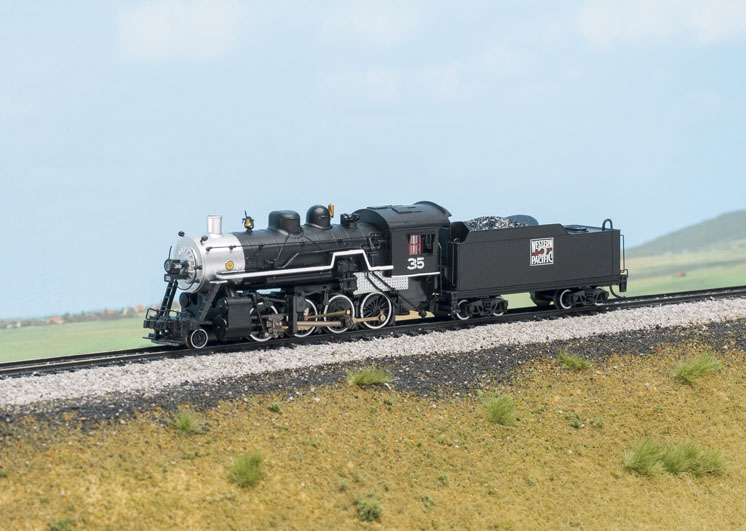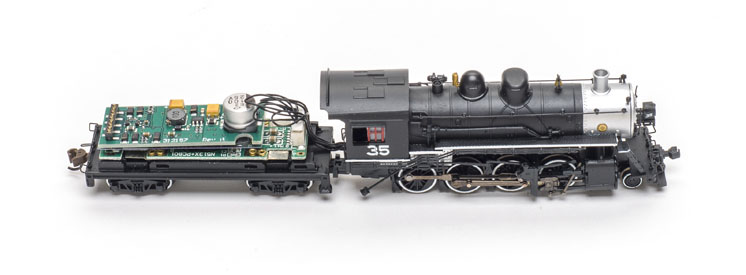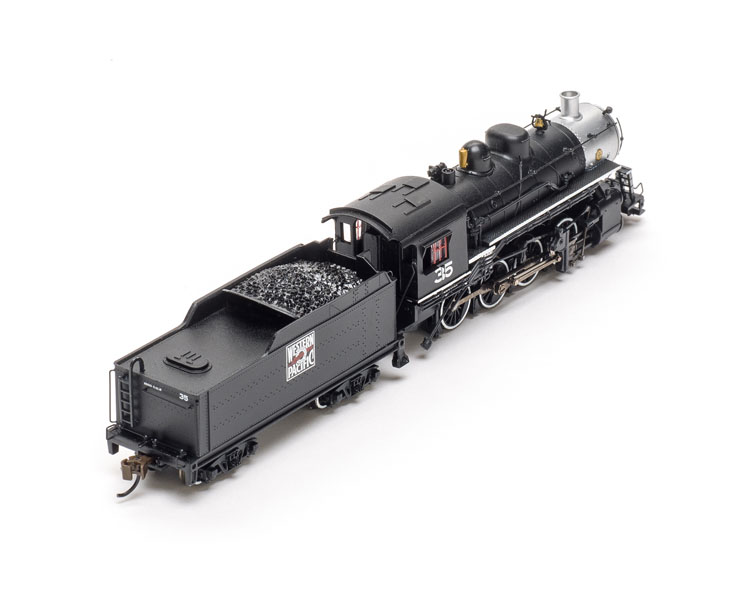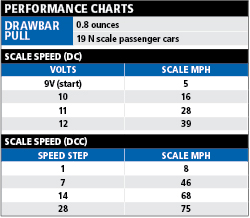It was only a few months ago – in the September 2018 issue – that we last reviewed a Baldwin 2-8-0 steam locomotive from Bachmann. But that was an HO scale model. Bachmann’s new Consolidation is an N scale model. This freight hauler is well detailed, nicely decorated, and despite its small size, a strong puller. It’s also packed with features thanks to its dual-mode SoundTraxx Econami decoder.
The Consolidation was most railroads’ go-to freight engine at the beginning of the 1900s. Its four low drivers produced traction, not speed, letting it haul longer, heavier trains up steeper grades than the speedier 4-4-0s or lighter Moguls. Even after the development of engines with larger fireboxes like 4-6-2 Pacifics and 2-8-2 Mikados, new Consolidations continued to be built well into the 1930s, incorporating new technologies like superheaters. It wasn’t until after World War II that the last of the 2-8-0s dropped fire.
A generic model. The Bachmann Consolidation doesn’t follow a particular prototype. Rather, like the company’s HO scale model, it’s a modified, more generic version of a Baldwin 2-8-0 built for the Illinois Central from 1909 to 1911. Drawings of the IC engine appear in Model Railroader Cyclopedia: Volume 1, Steam Locomotives (Kalmbach Books, out of print), and Bachmann’s model bears it some resemblance.
Some dimensions and details differ, though, such as the driver wheelbase. On the model, this has been stretched about a foot to accommodate its proportionally deeper wheel flanges. The engine also has a smaller, more rounded sand dome than the IC engine’s broad, flat one.
Trailing behind is a United States Railroad Administration-style short-haul tender, a design developed after 1918. Even though there was no such thing as a USRA Consolidation, it’s conceivable such a tender could have replaced the original.
Our model came painted as Western Pacific no. 35. According to the WP’s 1938 locomotive roster, no. 35 was indeed a Consolidation, built in 1909, though by Alco, not Baldwin. The Alco prototype had 57″ drivers, which match those on the Bachmann model, but other dimensions on the model more closely resemble the IC Baldwin.
First look. Our sample is a handsome model, smoothly painted satin black with a silver smokebox and firebox. White stripes and wheel rims make the engine stand out on the roundhouse tracks. The printing is crisp and opaque, and even the builder’s plate on the side of the smokebox (dated July 1918) is legible under magnification.
The wire handrails and coupler lift bars are close to scale thickness. The whistle and bell are metal castings. There was a small amount of flash on the flexible engineering-plastic piping. One of the pilot ladders was warped and wouldn’t stay in the mounting hole on the side of the smokebox without glue.
The locomotive comes fitted with a plastic E-Z Mate Mark II knuckle coupler on the rear, mounted at the correct height. The front has a dummy coupler. Though it was easy to remove the dummy, I saw no means of mounting a working coupler without making modifications to the pilot.
The model picks up power from all eight tender wheels and six drivers; there are rubber traction tires on the third set of drivers. According to the National Model Railroad Association standards gauge, all the drive wheels were in gauge, but the wheelsets on the pilot truck and tender were slightly tight. This didn’t cause problems when I tested the engine on the Peco medium-radius turnouts on our N scale Canadian Canyons project layout, though.
On the test track. I tested the locomotive first under direct current. The dual-mode decoder responded with a startup sequence at just under 6 volts. At 9 volts, the headlight came on and the locomotive started to roll at 5 scale mph. The bell clanged for about 15 seconds after starting, then shut off. At 12 volts, the engine reached 39 scale mph, which is an acceptable top speed for a Consolidation; the prototype maxed out around 45 scale mph. Just to check I turned the throttle all the way up to 14V, at which voltage the model zipped along at 61 mph.
Under Digital Command Control, the engine was even speedier. With the throttle set to 28 speed steps, the engine responded to speed step 1 at 8 scale mph. It topped out at 75 smph at speed step 21, before even getting to step 28.
However, setting up a simple three-point speed curve is easy in DCC. I programmed configuration variable (CV)5, commonly called Vmax, to a fairly low value of 64. This cut the locomotive’s top speed under DCC to a more prototypical 47 scale mph. Programming CV2, or Vstart, to 0 didn’t improve the engine’s low-speed performance, though – that CV apparently defaults to 0. However, when I set CV6, or Vmid, to 20, that low value stretched the lower end of the speed curve. This had the effect of reducing the engine’s speed at step 1 to a stately 2.6 smph, perfect for switching.
To test the engine’s real-world performance, I put it on the rails of the staging yard on our Canadian Canyons project layout and hooked it up to a train. The engine performed like a champ, tugging a 7-car train up the 13″ radius and 1.9 percent curve of the helix.
I had more control over the sound effects with Digital Command Control. I could trigger a long whistle blast with function key 2 and a short toot with F3. Function 4 opened the cylinder cocks and F10 triggered a blowdown. One cool effect was the Drift function, which muted the engine chuffs and turned up the side-rod clank when I hit F5 (key F6 put things back to normal). I also liked the fact that when I turned on the headlight, I could hear the dynamo spin up, even if the light stayed off because the engine was in reverse. All the functions can be easily remapped, using the decoder’s Flex-Map technology.
Programming the decoder. I prefer to be able to control my locomotives’ headlights directly, rather than having them turn on and off or dim automatically when I put the engine in reverse. So that was one of the first things I programmed into the decoder (after setting its short address to the cab number of 35, of course). Programming CV49, the headlight function, to 0 made it a simple on/off switch, rather than directionally dimming. I tried adding 128 to that value to activate what the SoundTraxx Econami Sound Value manual called LED (light-emitting diode) Compensation Mode, but the headlight didn’t look any brighter to me either way.
During testing I noted that the chuff sounds weren’t synchronized to the wheels, sounding about three times per rotation rather than the prototypical four. Programming a value of 75 into CV114 gave me the desired four chuffs per wheel revolution.
Finally, just for fun, I tweaked some of the sound effects. Bachmann’s Quick Start manual says that the decoder comes with three selectable whistle sounds and doesn’t mention bell options. However, the SoundTraxx manual lists 16 whistles and six bell sounds, which I confirmed are available on the decoder. By programming CV120 to 0, I selected a Lunkenheimer three-chime whistle, and setting CV122 to 10 selected a medium brass bell with a pleasing manually-rung cadence. The manual also lists options for the exhaust chuffs, air pumps, and dynamo sounds, but I left those at the defaults. The user manual is available at the SoundTraxx site, www.soundtraxx.com.
A must-have. More 2-8-0s were built than any other steam engine wheel arrangement, and they ran on practically every railroad in the country for half a century. This makes the Consolidation a must-have for N scale steam modelers. Bachmann’s model is a worthy choice.
Manufacturer
Bachmann Trains
1400 Erie Ave.
Philadelphia, PA 19124
www.bachmanntrains.com
Era: 1918 to late 1930s, as detailed
Road names: Western Pacific, New York Central, Norfolk & Western, Union Pacific, and Western Maryland
Features
Blackened metal wheelsets (pilot truck and tender wheels were slightly tight)
E-Z Mate Mark II knuckle coupler on rear, mounted at correct height (dummy coupler on front)
Light-emitting diode (LED) headlight
SoundTraxx Econami dual-mode
sound decoder
Weight: 3.3 ounces (engine and tender), 2.4 ounces (engine alone)

















